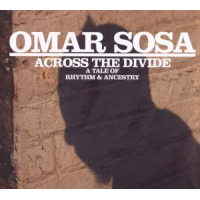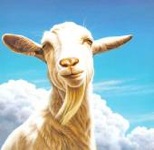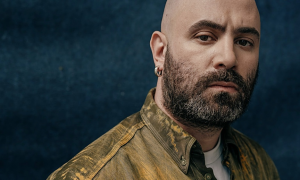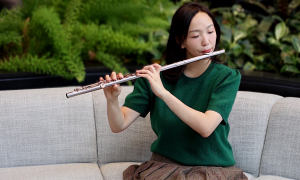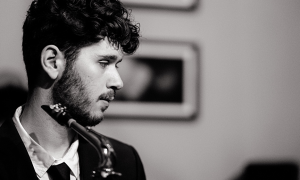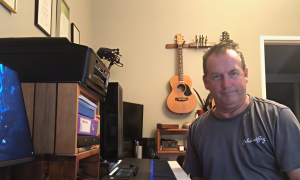Home » Jazz Articles » Take Five With... » Take Five With Jim Hession
Take Five With Jim Hession
 Meet Jim Hession:
Meet Jim Hession:I started my career in Los Angeles at age 14 when I moved from classical piano to early jazz. By 16 I had joined the AFM and was working professionally. Piano work put me through UCLA music school, particularly at Disneyland and Mickie Finn's (San Diego) where I met my wife Martha (my vocalist), and we began our personal and musical lives.
We spent 36 years performing for DL-WDW in addition to jazz clubs, resort hotels, theaters and concert venues. In 1969 I met the elder statesman of jazz, Eubie Blake, and was signed to his new record label. Eubie and I made joint appearances on both coasts for the next 13 years. After working in Florida for the 1970s, Martha and I and our growing family moved back to L.A. We did extensive work at the Variety Arts Theater and most West L.A. venues (hotels, country clubs, theaters, jazz clubs).
In 1985 we began a regular jazz gig with our American Jazz Quintet at Jax's, which ran for 15 years. During this time we had our own special on PBS, On Stage L.A., and appeared with Al Hirt on HBO's America's Music. After several years as pianist at DL's Grand Californian Hotel we relocated to the Gulf Coast in 2003 to continue our work in jazz/jazz history among the venues of New Orleans. This has led to many concerts for the National Jazz Park and appearances at the various Jazz Festivals in and around New Orleans.
In 2007 we began a regular series of recording dates at Word Of Mouth Studios, resulting in three new CDs with several more in the can. The response to my YouTube videos of jazz piano styles from mainstream to ragtime was a pleasant surprise. I started a series of free instructional videos which centered around stride piano, ragtime, and boogie styles. We also answer hundreds of questions about how to play early jazz and email rare piano solos to young pianists around the world who are anxious to learn these styles.
Presently we are developing our new websites to incorporate all of the data and media involved in our careers. We also have been selected as performers for both the Mississippi Arts Commission and Southern Artist Registry.
Instrument(s):
Piano.
Teachers and/or influences?
Teachers:
Oscar Rasbach-classical piano-1959-1962
Eubie Blake-piano styles/interrupted bass/rhythms.
Paul Chihara(UCLA)-composition.
Lalo Schifrin(UCLA)-motion picture composition.
Alden Ashforth(UCLA)orchestration.
Johnny Guarnieri-keyboard improv./odd meters.
Milcho Leviev-jazz improv.
Influences:
Oscar Peterson: piano jazz/blues technique;
Dave Brubeck: keyboard odd meter improv;
Teddy Wilson: voicings,melodic improv;
George Shearing: multi-voiced improv;
Errol Garner: L.H. strum acc.;
Chick Corea: melodic/rhythmic/harmonic concepts;
Art Tatum: humility;
Eubie Blake: musical structure/dynamics/voicings;
James P. Johnson: stride/RH,LH independence;
Michel Petrucianni: dynamic lead playing;
Fats Waller: swinging stride;
Luckey Roberts: dramatic flourishes/drive;
Earl Fatha Hines: "trumpet" piano/versatile LH;
Dick Hyman: superior technique and inventiveness;
Thelonious Monk: stretching the harmonic ear;
Jelly Roll Morton: first piano inspiration;
Curtis Peagler (the Basie/Ray Charles saxman who was with our band, The AJQ, for 8 years: Patience, dynamics, musicianship, the blues and jazz phrasing.
It is to be noted that Eubie Blake was the teacher/mentor of James P.Johnson, Luckey Roberts, Earl Hines and myself.
I knew I wanted to be a musician when...
When taking classical lessons from age 11 I was driven to practice exercises 40/50 times the given daily assignment. When learning jazz from recordings I would not stop working on a transcription until I had learned and analyzed it completely.
Playing piano for me was always a labor of love. After my first quarter in college I switched my major to music theory and composition and never looked back. What seemed difficult to others was just plain joy for me.
Your sound and approach to music:
I like to approach the solo piano as its own orchestra. Full bass accompaniment and solo lines, fluid right hand lines and figures, double hand unison/harmony lines and multi-voiced chord figures. For me, important factors are improvisation, alternate RH/LH lead lines, dynamics, complex rhythms and a solid sense of form,both in 4-8- 12 bar phrases and in constructing a solo from start to finish.
My approach to established jazz forms (i.e. New Orleans Jazz, stride, boogie woogie...) is to perform the piece within the style while being inventive with fresh ideas that stretch the conventional limits. My approach to mainstream/contemporary jazz is simple: improvisation and drive.
My approach to band playing is to support the lead instrument harmonically and rhythmically, providing counter melodies when appropriate. I prefer to give the bassist freedom to lay down the steady beat with the lines of his choice, and reserve the right to utilize the entire range of the piano (even the bass) for harmonic changes/substitutions and rhythmic figures that complement the drums—similar to the approach of Earl Fatha Hines in his small group context. I prefer to work with a small (3-5 piece) jazz group consisting of top-notch players who challenge the others and contribute to the interplay with inspired ideas and musical passages.
Your teaching approach:
I do not teach beginners. I teach players who have a working knowledge of the keyboard and have as much of a grasp of musical theory as possible. I start by having the student play a few selections so I can determine their level, then ask them what they want to accomplish musically. Depending on what they need ( (technique, fingering, theory, pedal, etc), I then attempt to get them from point A (where they are) to point B (where they want to be).
Your dream band:
My "dream band" would be our own American Jazz Quintet (formed in 1984) with my wife Martha on vocals, myself on piano, and saxophone, string bass and drums. The individual sidemen should be technically versatile musicians with a healthy sense of drive, enthusiasm and improvisation, to contribute to the group sound and inspire the other soloists. A band comprised of soloists to us is the most fun and exciting group to work with...five musicians performing entirely without a net.
What do you think is the most important thing you are contributing musically?
Establishing a concept that even within the confines and restrictions of established jazz styles (trad jazz, stride, boogie...) there is room for innovation, experimentation and creativity. This applies equally to the three basic elements of music: melody, harmony, and rhythm. I believe in taking chances and in the act of improvisation one should always be curious and interested in what is going to happen next.
Desert Island picks:
Michel Petrucianni/Jim Hall/Wayne Shorter, The Power of Three;
Carmen McRae, Carmen Sings Monk;
Art Tatum, The Essential Art Tatum;
George Shearing/Brian Torff, Live From Blues Alley;
Ella Fitzgerald, Ella in Hollywood.
How would you describe the state of jazz today?
Some would say "multi-faceted; others would say "fragmented." A positive sign is the emergence of satellite radio jazz stations; a not so positive sign is the over-commercialization of major "jazz festivals," where increasingly the headliners are actually pop stars (i.e. James Taylor, Bon Jovi etc.) booked to insure large crowds—a far cry from the peak years of the Monterey or Newport Jazz Festivals. At least New Orleans calls it "Jazz and Heritage Festival"—an all-encompassing term. After all, is there any type of music that doesn't have its own heritage?
What are some of the essential requirements to keep jazz alive and growing?
Spreading the word to the general public in a language that they can understand. Obtaining the co-operation of producers, festival organizers, club owners and governmental grant agencies to do their part so that we can do ours.
What is in the near future?
That "rich and famous contract" that the employer does not try to violate by using the small print. New recordings are constantly in the offing—many studio cuts are in the can, waiting for funding. Tour dates: tell us where to show up, what to wear and show me the money! To continue to teach via PBS shows and concerts. I need funding to finish my series on early piano styles on DVD.
Tags
PREVIOUS / NEXT
Support All About Jazz
 All About Jazz has been a pillar of jazz since 1995, championing it as an art form and, more importantly, supporting the musicians who make it. Our enduring commitment has made "AAJ" one of the most culturally important websites of its kind, read by hundreds of thousands of fans, musicians and industry figures every month.
All About Jazz has been a pillar of jazz since 1995, championing it as an art form and, more importantly, supporting the musicians who make it. Our enduring commitment has made "AAJ" one of the most culturally important websites of its kind, read by hundreds of thousands of fans, musicians and industry figures every month.



